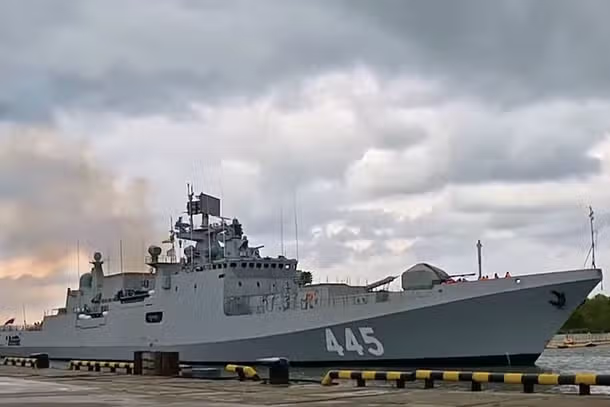- Courses
- GS Full Course 1 Year
- GS Full Course 2 Year
- GS Full Course 3 Year
- GS Full Course Till Selection
- Answer Alpha: Mains 2025 Mentorship
- MEP (Mains Enrichment Programme) Data, Facts
- Essay Target – 150+ Marks
- Online Program
- GS Recorded Course
- Polity
- Geography
- Economy
- Ancient, Medieval and Art & Culture AMAC
- Modern India, Post Independence & World History
- Environment
- Governance
- Science & Technology
- International Relations and Internal Security
- Disaster Management
- Ethics
- NCERT Current Affairs
- Indian Society and Social Issue
- NCERT- Science and Technology
- NCERT - Geography
- NCERT - Ancient History
- NCERT- World History
- NCERT Modern History
- CSAT
- 5 LAYERED ARJUNA Mentorship
- Public Administration Optional
- ABOUT US
- OUR TOPPERS
- TEST SERIES
- FREE STUDY MATERIAL
- VIDEOS
- CONTACT US
Sailing into Self-Reliance: The Legacy of INS Tamal
Sailing into Self-Reliance: The Legacy of INS Tamal

Why in the News?
- In July 2025, INS Tamal, a stealth multi-role frigate was commissioned at Yantar Shipyard, Russia.
- It is considered to be India’s last foreign built imported ship.
- It is a major milestone for the military, which has put efforts to indigenise the shipbuilding over years by increasing the indigenous contents slowly in the warships as well as designing them in India.
Key Highlights
- Background
- INS Tamal is the eighth Talwar class frigate, which is an improved version of the Krivak-III class frigates.
- It is the second of four additional follow-on ships of the class that was ordered in 2018.
- First was INS Tushil, commissioned in December 2024
- Second is INS Tamal, commissioned in July 2025
- Third is INS Triput, expected to be commissioned in 2026
- Fourth will be INS Tavasya.
- INS Triput and Tavasya will be built by Goa Shipyard Limited with transfer of technology and design assistance from Russia.
- INS Triput will be India’s first indigenously built Talwar class frigate.
- About INS Tamal
- It is a stealth, multi-role frigate belonging to the upgraded Krivak (Tushil) class series.
- The name “Tamal” is derived from the mythical sword wielded by Indra, the King of the Gods in Indian mythology.
- The ship’s mascot blends Indian and Russian symbolism, drawing from ‘Jambavant’, the immortal bear king, and the Eurasian Brown Bear, Russia’s national animal.
- It has a maximum speed of 30 knots and a range up to 4850 nautical miles
- Crew: 250 sailors and 26 officers
- Home port: Karwar, Karnataka
Frigates: A Brief Historical Overview
|
Tamal: A Moving Sea Fortress
- The Indian Navy described INS Tamal as a “formidable moving fortress at sea” because it can operate in all four key areas of naval warfare that is air, surface, underwater and electromagnetic warfare.
- Air
- It carries 2 kinds of anti-aircraft missiles
- 24 vertically launched Shtil surface to air missiles with a range of up to 70 km.
- 8 short range Igla missiles.
- It also has two fully-automated AK-630 guns, 30 mm rotary cannons that can fire over 5,000 rounds per minute,
- It is to protect the ship from close-range threats like enemy aircraft, missiles, and small boats using radar and camera-based targeting.
- It carries 2 kinds of anti-aircraft missiles
- Surface
- It is armed with eight BrahMos supersonic cruise missiles for attacking enemy ships and land targets
- These can travel at speeds of up to Mach 3 (3,700 km/h) and have a range of several hundred kilometres
- It also has a 100 mm A-190E main gun that can fire 25 kg shells to over 20 km.
- Underwater
- It is equipped for anti-submarine warfare with an RBU rocket launcher that can fire 12 depth-charge rockets at once
- It also has two 533 mm torpedo tubes that launch heavyweight torpedoes to destroy enemy submarines.
- Electromagnetic Warfare
- INS Tamal has high-tech Electronic Warfare (EW) systems and Electro-Optical/Infrared (EO/IR) sensors that help detect enemies and block their radar.
- It can also carry two types of helicopters:
- Kamov 28 – used to find and attack submarines
- Kamov 31 – used for airborne early warning to detect enemy aircraft and ships from far away
- These helicopters make the ship much more powerful in battle and are called "force multipliers" by the Navy.
- INS Tamal has a stealthy design and offers greater stability in rough sea conditions.
- It is equipped with automated systems for nuclear, biological, and chemical (NBC) defence.
- It also has centralised systems for firefighting and damage control, which can be operated from safe, protected areas.
- These features help reduce casualties and quickly restore combat readiness, improving the ship’s overall survivability.
India’s Naval Indigenisation Journey
|
Time Period |
Key Developments in Naval Indigenisation |
|
Post- Independence to 1960s |
|
|
1970s–1990s |
|
|
2000s |
|
|
2005–2010 |
|
|
2011–2021 |
|
|
2021–Present |
|
|
2025 and Beyond |
|
What is Defence Indigenisation?
Importance of Defence Indigenisation for India
|
Challenges and Way Forward
|
Challenges |
Way Forward |
|
1. Technological DependenceMany critical systems like engines, radars, and sonar are still imported. |
1. Invest in indigenous R&D and support defence tech startups to develop core technologies in-house. |
|
2. Capacity Constraints in ShipyardsDelays due to infrastructure gaps and project inefficiencies. |
2. Upgrade shipyard infrastructure and adopt modern project management tools for faster execution. |
|
3. Design LimitationsAdvanced warship design capabilities are still evolving. |
3. Strengthen the Directorate of Naval Design (DND) and promote collaboration with top academic and tech institutions. |
|
4. Skilled Workforce ShortageLimited availability of specialised engineers and technicians. |
4. Launch skill development programs focused on naval architecture, engineering, and defence manufacturing. |
|
5. Strategic Risks of Import DependenceHeavy reliance on foreign suppliers like Russia poses geopolitical vulnerabilities. |
5. Encourage joint ventures and technology transfer under Make in India and reduce foreign dependency gradually. |
|
6. Fragmented Industry EcosystemLack of strong integration between public and private sector players. |
6. Build a robust public-private partnership (PPP) model and incentivise private sector participation in defence. |
Conclusion
The commissioning of INS Tamal marks the end of India’s dependence on imported warships and reflects the success of a decades-long indigenisation push. While challenges remain in technology and infrastructure, India is firmly on the path to becoming self-reliant in naval defence, with a vision to build and design all future warships domestically. This transition is crucial for strategic autonomy and defence preparedness.
|
Ensure IAS Mains Question Q. “The commissioning of INS Tamal marks a turning point in India’s naval indigenisation journey.” Critically analyse the importance of defence indigenisation for India in the context of national security, economic development, and strategic autonomy. Also, discuss the challenges in achieving complete self-reliance and the way forward. (250 words) |
|
Emsure IAS Prelims Question Q. Consider the following statements about India’s naval indigenisation and INS Tamal:
Which of the statements given above is/are correct?
Answer: b Explanation Statement 1 is incorrect: INS Tamal was built in Russia and INS Triput will be India’s first indigenously built Talwar-class frigate. Statement 2 is correct: INS Tamal is capable in all four domains: air, surface, underwater, and electromagnetic warfare. Statement 3 is correct: The Directorate of Naval Design (DND) was set up in 1970, whereas the Directorate of Indigenisation came later in 2005. |


